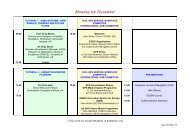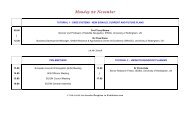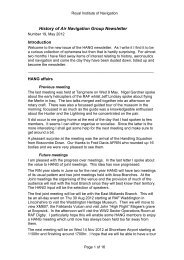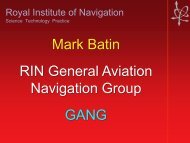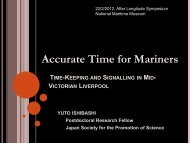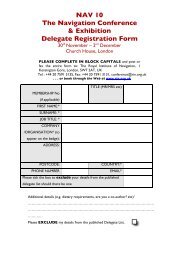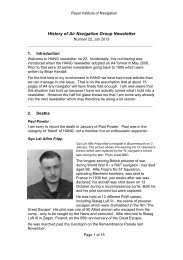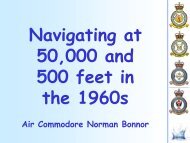Fairway 30 - Royal Institute of Navigation
Fairway 30 - Royal Institute of Navigation
Fairway 30 - Royal Institute of Navigation
You also want an ePaper? Increase the reach of your titles
YUMPU automatically turns print PDFs into web optimized ePapers that Google loves.
• Integrate and present information onboard and ashore that maximizes navigation<br />
safety benefits and minimizes any risk <strong>of</strong> confusion<br />
• Facilitate global coverage with consistent standards and interoperability.<br />
This will be achieved by the use <strong>of</strong> global voice and data communications, electronic<br />
positioning and timing and electronic charts.<br />
Use will be made <strong>of</strong> virtual Aids-to-<strong>Navigation</strong>. This new concept will allow the GLA’s<br />
members to mark new hazards on a ship’s electronic chart within the required six hour<br />
time slot, prior to deploying a real buoy. Collision avoidance is another concern<br />
addressed by the idea <strong>of</strong> e<strong>Navigation</strong>. The majority <strong>of</strong> accidents are due to human error.<br />
The use <strong>of</strong> existing and new vessel sensors will improve situational awareness and<br />
provide decision support to the crew. By this means it will be possible to place a virtual<br />
ring round a vessel and to trigger an alarm should another one seem to be encroaching<br />
inside it. Passage planning would be simplified by making the necessary information<br />
more accessible, having it organized and clearly presented in a standard and<br />
unambiguous form.<br />
Looking at a slightly different field, Sally pointed out that navigation technology, and<br />
GPS in particular, had migrated into the consumer field with items like the iPhone.<br />
Although the equipment had been made simple to operate, may <strong>of</strong> the problems and<br />
complaints about “GPS” were in fact due to poor mapping or to poor input. She quoted<br />
one journey by land to Capri which ended up in Carpi at the other end <strong>of</strong> Italy,<br />
presumably with no checks being made on the way there.<br />
With greater dependence on GMDSS, a flawed hero, it had nevertheless revolutionized<br />
PNT, its performance had improved but it was likely to change its relationship with us,<br />
going from enabler (easier navigation) to enforcer (possible road pricing). Its known<br />
vulnerabilities have brought about innovation with DGPS, increased sensitivity and<br />
EGNOS / WAAS. Jammers, though, still present a very real difficulty. These are<br />
available and are being used by criminals, especially on the Continent in the theft <strong>of</strong><br />
expensive cars and valuable lorry cargos. Not only do they defeat the tracking systems,<br />
they also prevent the use <strong>of</strong> mobile phones.<br />
Examples <strong>of</strong> the failure <strong>of</strong> GMDSS were given. THV Alert complained in 2007 that its<br />
GPS receiver was becoming irregular. It was discovered that its antenna cable had<br />
become a jammer instead <strong>of</strong> just a passive aerial. In December 2006 a solar flare<br />
produced ten times more radio noise that the previous highest recorded figure, even<br />
though it was at solar minimum. This had blocked GPS over most <strong>of</strong> the sunlit side <strong>of</strong><br />
the earth, as well as causing failure <strong>of</strong> the electricity supply. Off Flamborough Head she<br />
herself had taken part in jamming tests. A 1.5 watt jammer had successfully defeated<br />
GPS for <strong>30</strong> kilometres out to sea. As the test vessel approached the jammed area the side<br />
lobes produced false information, the receiver believing the signal to be good but<br />
31




